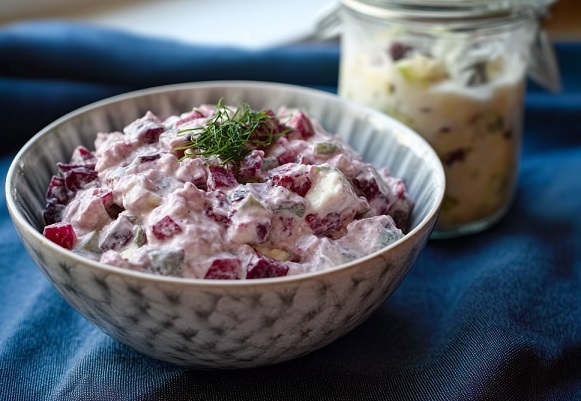
Delicate, creamy, and mildly tangy – Matjessalat, or Matjes herring salad, is a northern German favorite that combines young herring fillets with apples, onions, and a smooth dairy-based dressing. It’s a lighter, subtler cousin to the bolder Heringssalat, making it perfect for warm weather or those new to pickled fish.
Matjessalat’s flavors reflect the maritime roots of northern Germany and the region’s love for balancing savory seafood with sweet and sour elements.
The Origins of Matjessalat Recipe
Matjes herring – from the Dutch word maatjesharing meaning “virgin herring” – refers to young, mild, lightly salted herring that is caught before the fish reach maturity. This gentle curing process results in a buttery texture and mellow flavor.
The tradition of serving herring salads during religious holidays like Ash Wednesday or New Year’s Eve extends to Matjessalat, though it’s also eaten throughout spring and summer as a cool and satisfying meal. In coastal cities like Hamburg and Bremen, it remains a mainstay of cold plates and bistro menus.
Looking for more refreshing German dishes? Explore our archive of German Salad Recipes for year-round inspiration.
Ingredients for Authentic Matjessalat
- 250 g Matjes herring fillets (mild, salted)
- 1 small apple, peeled and finely chopped
- 1 small onion, thinly sliced
- 2–3 pickles (gherkins), chopped
- 100 ml sour cream
- 100 ml plain yogurt or crème fraîche
- 1 tablespoon pickle juice or apple cider vinegar
- 1 teaspoon mild mustard
- Salt and pepper to taste
- Optional: chopped dill or chives for garnish
Kitchen Tools You’ll Need:
- Knife and cutting board
- Mixing bowl
- Spoon or spatula
- Whisk (for dressing)
How to Make Matjessalat (Step-by-Step Instructions)
Step 1: Prepare the Matjes Herring
If the fillets are too salty, soak them in cold water or milk for 20–30 minutes. Pat dry, then cut into bite-sized pieces.
Step 2: Chop the Additions
Dice the apple and pickles. Slice the onion into thin rings or half-moons. Add all to a large mixing bowl.
Step 3: Make the Dressing
In a separate bowl, whisk together sour cream, yogurt or crème fraîche, mustard, and pickle juice. Season lightly with salt and pepper (remember the fish is already salty).
Step 4: Combine and Mix
Add the herring pieces to the salad bowl. Pour the dressing over the ingredients and mix gently. Let the salad rest in the fridge for at least 30 minutes before serving.
Step 5: Serve Chilled
Garnish with chopped fresh herbs just before serving. Matjessalat should be served cold for the best texture and flavor.
How to Serve Matjessalat
Matjessalat is traditionally served as a light lunch or part of a Brotzeit spread. It goes beautifully with boiled potatoes, rye bread, or a crusty roll. In some regions, it is paired with sliced hard-boiled eggs or served atop a salad bed for a modern twist.
You can also enjoy it as part of a festive spread with Kartoffelsalat, Gurkensalat, and Eiersalat.
For drinks, Matjessalat pairs well with a crisp German pilsner, dry white wine (such as Silvaner), or a shot of aquavit for something traditional.
Variations and Regional Twists
With Beets:
Some versions include diced cooked beetroot for color and an earthy contrast.
With Horseradish:
Adds a sharp bite – great if you like your salads on the spicier side.
With Cream Cheese:
Replacing part of the yogurt with German Quark or cream cheese gives a richer consistency.
With Capers or Olives:
These Mediterranean additions are rare but found in some modern variations.
Scandinavian Influence:
In Northern Germany, Danish and Dutch influences may bring in red onion, dill, or extra mustard in the dressing.
Matjessalat is a creamy, coastal delight that offers the perfect introduction to German herring salads. With its subtle flavor and elegant texture, it’s both refreshing and satisfying – ideal for spring brunches, summer dinners, or holiday spreads.
Try this classic recipe and bring a taste of North Sea tradition to your kitchen. Want more festive German salads? Explore Heringssalat, Wurstsalat, or the full collection of German Salad Recipes.







